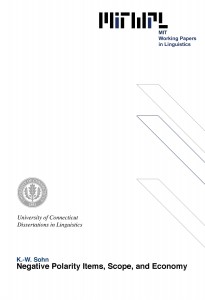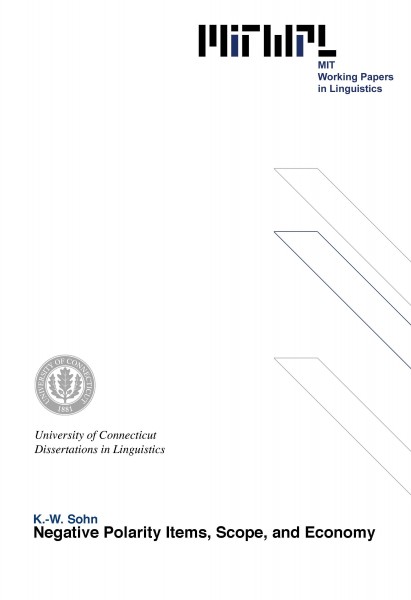Negative Polarity Items, Scope, and Economy
K.-W. Sohn, 1995
The purpose of this thesis is to show that despite their superficial differences, languages are the same at a deeper level. The languages we deal with in the thesis are Korean, Japanese, and English, but the conclusions we draw from them are not limited to them. For this purpose, we take up two issues: the distribution of negative polarity items and scope phenomena. It has been observed that there are many differences in the behavior of negative polarity items (NPIs) in Korean, Japanese, and English (Suh (1990), etc.). Among them, the most heralded one is the different locality requirement between an NPI and its licenser among these languages. There is a strict locality requirement, often called clausemate condition, between an NPI and its licenser (negation) in the first two languages, while there is no such condition in English. Adopting the minimalist program (Chomsky, 1993), we provide a unified account for this parametric difference between these two types of languages, by proposing that the (Neg) feature of Korean and Japanese NPIs is strong while that of English NPIs is weak. Another well-known difference among these languages, the subject/object asymmetry in NPI licensing only attested in English is attributed to the different clausal architecture of these languages. It will be argued that Japanese and Korean can have a subject below negation while English only allows a subject in the position higher than negation (cf. Ahn (1991)).
Also, this thesis tries to provide a unified account for the scope phenomena in all of these languages. Departing from a prevalent belief that there are a great many differences between Korean/Japanese and English with respect to scope, we show that there are surprising similarities in their scope phenomena. First of all, we show that rigidity effects obtain not only in Japanese and Korean, but in English (Lasnik and Saito (1992)). Next, we derive these rigidity effects from economy considerations. We propose that at LF, a quantifier phrase (QP) adjoins to the closest maximal projection to take scope. Given this, economy dictates that when a QP undergoes A-movement in overt syntax, the first A-adjunction site of that QP is the position where it takes scope (cf. Abe (1993)). The reason is that the moved QP becomes lighter by discharging the feature(s) responsible for its quantificational force, thus obeying economy. Related to this, we also provide an account for why only in Japanese and Korean, overt movement (i.e. scrambling) of QP can override the rigidity effects, crucially relying on Mahajan (1990) and Saito (1992).
In conclusion, this thesis confirms the main claim of the minimalist program, that is, there is Universal Grammar which we are born with, and that the superficial differences among them result from the choice of different parameter(s).
Chapter I. Introduction .......................................................................1
Chapter Il. Negative Polarity Items and Their Licensing ...............................8
2.1. Negative Polarity Items and Parametric Differences ..............................8
2.2. Previous Analyses .....................................................................11
2.3. NPIs as Focus Barriers ................................................................22
2.4. Proposal ................................................................................27
2.5. Consequences ...........................................................................31
2.6. On the Nature of Neg Spec ...........................................................60
2.7. Short Form Negation and NPI Licensing ..........................................67
2.8. Strong Feature and Last Resort ......................................................82
2.9. Licensing of a Subject NPI ...........................................................85
2.10. NPI Licensing in English ...........................................................93
Chapter III. Interaction of A' Operations: Crossing and Minimality ...............108
3.1. Cotending Analyses .................................................................110
3.2. Argument for the LCC ..............................................................114
3.3. Substitution, Adjunction and the LCC ............................................117
3.4. Focus Movement and Scope .......................................................121
3.5. Challenge for the LCC ..............................................................132
3.6. The Nature of the LCC .............................................................141
Chapter IV. Rigidity and Scope .........................................................143
4.1. Is There a Rigidity Condition? .....................................................143
4.2. Neg-QP Scope Interaction .........................................................147
4.3. QP-QP vs. Neg-QP Scope Interaction .............................................161
4.4. Overt Movement of QPs in Japanese and Korean ...............................186
4.5. Specificity Revisited - The Universality of QP Interpretation .....................194
4.6. Scope Reconstruction and A-movement ..........................................201
4.7. Scope Interpretation Without Rigidity Condition ...............................213
4.8. Universal Qualifier in Korean and Japanese .....................................215
Chapter V. On Subject Positions .......................................................218
5.1. Evidence for the Lower Subject Position ........................................219
5.2. Higher Subject: What is its Source? ...............................................220
5.3. On Subject Positions ................................................................221
BIBLIOGRAPHY ........................................................................241

